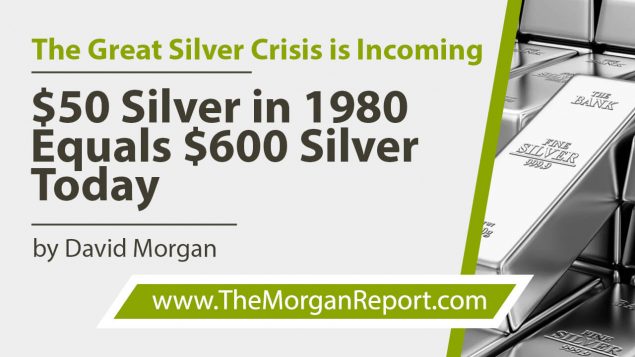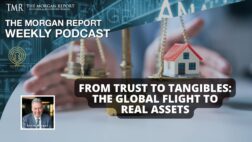- Market Analysis — Investing — Trading Methods At The Morgan Report For Only $50 Per Month. | http://www.themorganreport.com/join.
- Discover How YOU Can Cash-Flow Gold & Silver For A Passive Income Of 12% – 26.4% Per Year Just Like Real Estate… Get more details here.
- Starting your own precious metals savings program is an easy way to automatically save in gold and silver. This makes it easy to maintain a disciplined program for increasing your ownership of history’s most proven stores of value. Learn more here.
The Great Silver Crisis is Incoming
$50 Silver in 1980 Equals $600 Silver Today
I said this back in 2002: “For the record, I will state there will be another, more frenzied scramble, which will carry silver prices to highs that will repair all the excess paper money creation, price suppression, supply deficit, and bearish sentiment over the past two decades. This will become known as the Great Silver Crisis.”
When I wrote that, silver was valued at around $5.
Today, there is a great deal of buying pressure throughout the sector, not only in the retail market which has these huge premiums currently, but also in the commercial bar category, which would be primarily the silver ETFs.
Moreover, Sprott Asset Management, one of Canada’s top mining industry investment firms, has put a shelf filing for $1.5 billion, which would represent something near 80 million ounces of 0.999 fine silver in commercial bar form.
To put it simply, there’s a lot of buying pressure in both the silver and gold markets right now.
But it’s also likely we’re now entering the Great Silver Crisis. What does that mean? Well, the way I would define it, is that the Great Silver Crisis is truly verified when the commercial bar category is bought for industrial use and they panic.
Consider this: What if Apple decides that they can’t make 5G phones because they don’t have enough silver? What happens if it takes too long to acquire the silver they need to stay in business? Would they have to resort to shutting down a production line, until they could get silver? If this situation were to occur, It wouldn’t be long after until this trend spills over to Mitsubishi, then to the electric vehicle market, and ultimately to the entire electronic manufacturer industry.
So, when(if) the industrial part of the silver market, which is 60%, panics into buying silver because the silver market is drying up and must essentially warehouse silver, in fear of an impending shortage which would virtually take them out of business – that would be the greatest indicator of the Great Silver Crisis, in my eyes.
How close are we to that? We’re not that close yet… but we’re getting closer.
Demand for silver for industrial use is gaining traction and it has been since the turn of the century. In 2000, the amount of demand for industrial production was only 35% of the total market, and we were only mining 550 million ounces of silver. Today, it is at 60% of the total market, and we mine 850 million ounces of silver on an annual basis.
With this increase in volume, production has also ramped up within the same time frame. Think about it: if we had steady mining activity and only 550 million ounces of silver were mined today, almost 100% of it would be used for industrial purposes.
The demand for silver as an investment is very strong right now; when that spills over into industry, it’s not going to increase mining as there is waning of silver mining due to the crisis.
But what happens when investors take up the silver supply, and there isn’t any left for manufacturers to make their final product? When there isn’t enough silver readily available to produce refrigerators, toasters, or any smart-technology device for that matter? Manufacturers of these products rely on a just-in-time inventory, where they typically think there is an infinite supply of production materials. All except for silver.
This continued practice has proven ineffective by Ford Motor Company in the Palladium market, but you already know my take on that.
Now, on to gold…
There are two sides to every coin. Now, there’s clearly an increase in demand for gold and silver for monetary reasons. There is a price differential between New York and London. Refiners aren’t in the business of hoarding gold. They aren’t gold bugs, for the most part. They’re in the business of making money – currency in today’s world – and they saw an opportunity to take advantage of a price differential.
So, to take advantage of this arbitrage a great amount of gold was shipped and flown into New Youk.
The refiners will tell you that there’s been a lot of shipments into New York in the days of $14, $15, and $16 silver, along with equivalent prices at those time frames in gold, because there weren’t many buyers, so gold and silver was being stacked on the Comex.
Remember: all supply and demand must equal. So, as a refiner making 1,000-ounce silver bars, having no immediate demand turns to the buyer of last-resort, so to speak, which would be the exchanges. That’s the other side of the story.
The key price for silver is $26. That’s where the price held for three times technically after the 2011 high, and on the fourth, it went down through that level, and ever since silver went below $26, it’s been in bear mode until very recently.
But now… we’re finally back up over that level, and it seems to want to hold above that level. As we know, it went below it temporarily for a day or two of trading, but we’re back above it, and that is key. Technically and psychologically, there will be a lot more silver bought at $30 and higher than was bought below $18.
What now?
The best way I can explain it is this: there’s a point in Keynesian economics where you can stimulate the economy by printing money. And it works for a while. Then, there’s a point where you can just print and print and print. And then, it doesn’t work anymore.
Well, we’ve reached that point. We’re at a point now where the more you print, the worse it gets. People trust the money or the currency less and less, and it becomes worth less, then it is perceived to becoming worthless. That’s when you see greater demand than we’re already seeing. We’re just seeing the precursor to what will unfold.
We’re in the third leg now. The third leg, in any market, is the most substantive in price increases and typically lasts a short duration. That’s why I’ve been on the Internet many times, lecturing about one key fact: 90% of the move comes in the last 10% of the time.
Consider this: when the bull silver market started in the 70s, it went from the official monetary price of $1.29/oz to $6/oz in 14 years. But at the end of the decade, in January 1979, silver went from its all-time-high of $6/oz to an astounding $50/oz. That’s an 800% increase in the span of one year, which means, in 8% of the time, it made 87% of the move.
Now – are we going to repeat exactly that? Probably not. But the idea is very much the same. This happened in real estate, in the tech bubble, and in almost every market, so we’re truly just getting warmed up.
And a lot of people are asking – is it too late now to buy? No, it’s not. Think of yourself as the person buying silver in 1979, except the big difference is you’re buying silver with confirmation at $26, at a fraction of the price it should have been in a free market, which would at the very least put it at $50 today.
In January 1979 an investor was at a point where they were buying at an all-time high, and watching it go eightfold higher. Consider this: $50/oz silver in 1980, taking the CPI and inflation-adjusted price into account, amounts to $600/oz today.
If you look at the metrics that we used in 1980, where food and energy, the two things humans need most to survive, were not taken out of the CPI, we would have a much more honest calculation than we would today. It then becomes a simple math problem that shows $50 silver in 1980 is $600 silver right now, 40 years later.
Think about it like this: the $50 bill you held in 2011 wouldn’t buy you anything, relative to what it could buy you in 1980.
Let me emphasize that the $50 was a one day event, but if we look at the average price of silver in 1980, it was $20 per ounce, which means it was more than 300% higher than the highest price it had reached in January of the previous year. Something to think about? Do you think silver is undervalued and worth purchasing, or do you think the move is over?
I dove deep to discuss these concepts further in a recent interview with Greg Hunter of USAWatchDog. You can find the full interview on my blog, The Morgan Report, where I share key insights about today’s markets and how to best preserve wealth, informed by years of experience.
For more content like this, join our free newsletter – Go to the TheMorganReport.com and sign up.
Let My Passion Create Your Wealth.
I’ve Been Helping My Subscribers Weather the Current Economic Mess. Now I Invite You to Join My Growing Circle of Successful Investors.
The Morgan Report is all about YOU and how you can build and preserve Wealth for generations to come. We know it can sometimes seem a daunting task to protect your assets and preserve or grow your wealth. Over 15 years ago, a small group of us started The Morgan Report and formed an exclusive membership organization to promote personal freedom, an honest money system, free market wealth accumulation, and asset protection.
Thus was born The Morgan Report – since then we’ve helped 11,000-plus members scattered over the globe in every continent and over 100,000+ e-newsletter subscribers have read our weekly e-newsletter — This Week’s View from The Morgan Report.
Through our publication, The Morgan Report, we provide you with ways to achieve greater financial security and wealth in all sorts of environments.
Learn more and become an insider for The Morgan Report, click link below…
http://www.themorganreport.com/join
Special Riches In Resources Free Report
Because there is a 100% failure rate of ALL fiat money throughout history, you will learn what to do by obtaining your Free Report. Just enter your first name, your primary email address and click the Get Special Report button below.
Our mission statement reads…
“To teach and empower people to understand the benefits of an honest monetary system.”
Today’s monetary system is based upon a lie. The lie is that you can get something for nothing, or perhaps more simply stated, wealth can be printed. History has shown throughout 5000 years that whenever a country has tried to maintain this illusion (lie), failure has been the result. We invite you to learn more about what The Morgan Report can do for you. Click on the Learn More About The Morgan Report button now!




